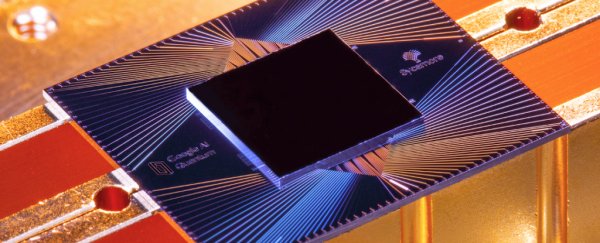Of the many high expectations we have of quantum technology, one of the most exciting has to be the ability to simulate chemistry on an unprecedented level. Now we have our first glimpse of what that might look like.
Together with a team of collaborators, the Google AI Quantum team has used their 54 qubit quantum processor, Sycamore, to simulate changes in the configuration of a molecule called diazene.
As far as chemical reactions go, it's one of the simplest ones we know of. Diazene is little more than a couple of nitrogens linked in a double bond, each towing a hydrogen atom.
However, the quantum computer accurately described changes in the positions of hydrogen to form different diazene isomers. The team also used their system to arrive at an accurate description of the binding energy of hydrogen in increasingly bigger chains.
As straight-forward as these two models may sound, there's a lot going on under the hood. Forget the formulaic chemical reactions from your school textbooks - on a level of quantum mechanics, chemistry is a complicated mix of possibilities.
In some ways, it's the difference between knowing a casino will always make a profit, and predicting the outcomes of the individual games being played inside. Restricted to the predictable rules of classical computers, an ability to represent the infinite combinations of dice rolls and royal flushes of quantum physics has been just too hard.
Quantum computers, on the other hand, are constructed around these very same principles of quantum probability that govern chemistry on a fundamental level.
Logical units called qubits exist in a fuzzy state of 'either/or'. When combined with the 'maybe' states of other qubits in a system, it provides computer engineers with a unique way to carry out computations.
Algorithms specially formulated to take advantage of these quantum mechanics allow for shortcuts, reducing down to minutes that which would take a classical super computer thousands of years of grinding.
If we're to have a hope of modelling chemistry on a quantum level, we're going to need that kind of power, and some.
Just calculating the sum of actions that determine the energy in a molecule of propane would hypothetically take a supercomputer more than a week. But there's a world of difference between a snapshot of a molecule's energy, and calculating all the ways they might change.
The diazene simulation used 12 of the 54 qubits in the Sycamore processor to perform its calculations. This in itself was still twice the size of any previous attempts at chemistry simulations.
The team also pushed the limits on an algorithm designed to marry classical with quantum processes, one designed to iron out the errors that arise all too easily in the delicate world of quantum computing.
It all adds up to possibilities of increasingly bigger simulations in the future, helping us design more robust materials, sift out more effective pharmaceuticals, and even unlock more secrets of our Universe's quantum casino.
Diazene's wandering hydrogens is just the start of the kinds of chemistry we might soon be able to model in a quantum landscape.
This research was published in Science.
